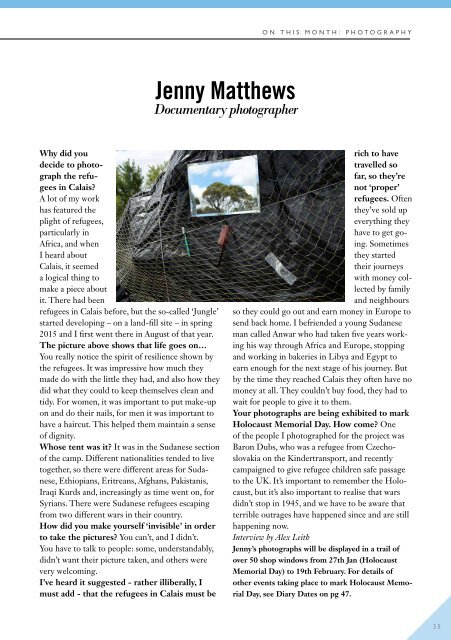Create successful ePaper yourself
Turn your PDF publications into a flip-book with our unique Google optimized e-Paper software.
ON THIS MONTH: PHOTOGRAPHY<br />
Jenny Matthews<br />
Documentary photographer<br />
Why did you<br />
decide to photograph<br />
the refugees<br />
in Calais?<br />
A lot of my work<br />
has featured the<br />
plight of refugees,<br />
particularly in<br />
Africa, and when<br />
I heard about<br />
Calais, it seemed<br />
a logical thing to<br />
make a piece about<br />
it. There had been<br />
refugees in Calais before, but the so-called ‘Jungle’<br />
started developing – on a land-fill site – in spring<br />
2015 and I first went there in August of that year.<br />
The picture above shows that life goes on…<br />
You really notice the spirit of resilience shown by<br />
the refugees. It was impressive how much they<br />
made do with the little they had, and also how they<br />
did what they could to keep themselves clean and<br />
tidy. For women, it was important to put make-up<br />
on and do their nails, for men it was important to<br />
have a haircut. This helped them maintain a sense<br />
of dignity.<br />
Whose tent was it? It was in the Sudanese section<br />
of the camp. Different nationalities tended to live<br />
together, so there were different areas for Sudanese,<br />
Ethiopians, Eritreans, Afghans, Pakistanis,<br />
Iraqi Kurds and, increasingly as time went on, for<br />
Syrians. There were Sudanese refugees escaping<br />
from two different wars in their country.<br />
How did you make yourself ‘invisible’ in order<br />
to take the pictures? You can’t, and I didn’t.<br />
You have to talk to people: some, understandably,<br />
didn’t want their picture taken, and others were<br />
very welcoming.<br />
I’ve heard it suggested - rather illiberally, I<br />
must add - that the refugees in Calais must be<br />
rich to have<br />
travelled so<br />
far, so they’re<br />
not ‘proper’<br />
refugees. Often<br />
they’ve sold up<br />
everything they<br />
have to get going.<br />
Sometimes<br />
they started<br />
their journeys<br />
with money collected<br />
by family<br />
and neighbours<br />
so they could go out and earn money in Europe to<br />
send back home. I befriended a young Sudanese<br />
man called Anwar who had taken five years working<br />
his way through Africa and Europe, stopping<br />
and working in bakeries in Libya and Egypt to<br />
earn enough for the next stage of his journey. But<br />
by the time they reached Calais they often have no<br />
money at all. They couldn’t buy food, they had to<br />
wait for people to give it to them.<br />
Your photographs are being exhibited to mark<br />
Holocaust Memorial Day. How come? One<br />
of the people I photographed for the project was<br />
Baron Dubs, who was a refugee from Czechoslovakia<br />
on the Kindertransport, and recently<br />
campaigned to give refugee children safe passage<br />
to the UK. It’s important to remember the Holocaust,<br />
but it’s also important to realise that wars<br />
didn’t stop in 1945, and we have to be aware that<br />
terrible outrages have happened since and are still<br />
happening now.<br />
Interview by Alex Leith<br />
Jenny’s photographs will be displayed in a trail of<br />
over 50 shop windows from 27th Jan (Holocaust<br />
Memorial Day) to 19th February. For details of<br />
other events taking place to mark Holocaust Memorial<br />
Day, see Diary Dates on pg 47.<br />
35


















